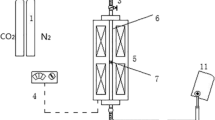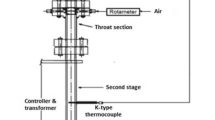Abstract
This work aims to investigate the importance of biomass char and the metal oxides in the ash in tar cracking during the volatile–char interactions. Experiments were carried out in a two-stage fixed reactor, and corncob, one typical agricultural biomass rich in potassium, was chosen as raw material. Results showed that char and char-supported potassium catalysts have good activity for tar elimination due to the good absorbability of char and catalytic property of potassium. In particular, tar conversion efficiency can reach 95.8% by using 1.5 K-char catalyst at 700 °C. The reforming reactions can be significantly enhanced during the volatile–char interactions in the presence of char and char-supported potassium catalysts. As a result, the syngas yield increased significantly with increasing temperature and supported K+, particularly the combustible gases including H2, CO and CH4. Physical and chemical structure of char changed due to reforming reactions related to the carbon, while the content of potassium was almost unchanged.










Similar content being viewed by others
References
Oliveira TJP, Cardoso CR, Ataide CH. Fast pyrolysis of soybean hulls: analysis of bio-oil produced in a fluidized bed reactor and of vapor obtained in analytical pyrolysis. J Therm Anal Calorim. 2015;120(1):427–38.
Anis S, Zainal ZA. Tar reduction in biomass producer gas via mechanical, catalytic and thermal methods: a review. Renew Sustain Energy Rev. 2011;15(5):2355–77.
Kaminska-Pietrzak N, Howaniec N, Smolinski A. The influence of feedstock type and operating parameters on tar formation in the process of gasification and co-gasification. Ecol Chem Eng S. 2013;20(4):747–61.
Abu El-Rub Z, Bramer EA, Brem G. Review of catalysts for tar elimination in biomass gasification processes. Ind Eng Chem Res. 2004;43(22):6911–9.
Schmidt S, Giesa S, Drochner A, Vogel H. Catalytic tar removal from bio syngas-catalyst development and kinetic studies. Catal Today. 2011;175(1):442–9.
Berrueco C, Montane D, Guell BM, del Alamo G. Effect of temperature and dolomite on tar formation during gasification of torrefied biomass in a pressurized fluidized bed. Energy. 2014;66:849–59.
Cheng XH, He XM, Chen C, Yi S. Influence of Fe2O3/CaO catalysts on the pyrolysis products of low-rank Coal. Energy Technol. 2015;3(10):1068–71.
Cheah S, Gaston KR, Parent YO, Jarvis MW, Vinzant TB, Smith KM, et al. Nickel cerium olivine catalyst for catalytic gasification of biomass. Appl Catal B Environ. 2013;134:34–45.
Zhang YL, Wu WG, Zhao SH, Long YF, Luo YH. Experimental study on pyrolysis tar removal over rice straw char and inner pore structure evolution of char. Fuel Process Technol. 2015;134:333–44.
Min ZH, Yimsiri P, Asadullah M, Zhang S, Li CZ. Catalytic reforming of tar during gasification. Part II. Char as a catalyst or as a catalyst support for tar reforming. Fuel. 2011;90(7):2545–52.
Shen YF, Zhao PT, Shao QF, Takahashi F, Yoshikawa K. In situ catalytic conversion of tar using rice husk char/ash supported nickel-iron catalysts for biomass pyrolytic gasification combined with the mixing-simulation in fluidized-bed gasifier. Appl Energy. 2015;160:808–19.
Zhang SP, Dong Q, Zhang L, Xiong YQ. High quality syngas production from microwave pyrolysis of rice husk with char-supported metallic catalysts. Bioresour Technol. 2015;191:17–23.
Zhang S, Asadullah M, Dong L, Tay HL, Li CZ. An advanced biomass gasification technology with integrated catalytic hot gas cleaning. Part II: tar reforming using char as a catalyst or as a catalyst support. Fuel. 2013;112:646–53.
Formella KLP, Sulimma A, van Heek KH, Jüntgen H. Interaction of mineral matter in coal with potassium during gasification. Fuel. 1986;65:1470–2.
Tsai WT, Chang CY, Lee SL, Wang SY. Thermogravimetric analysis of corn cob impregnated with zinc chloride for preparation of activated carbon. J Therm Anal Calorim. 2001;63(2):351–7.
Trninic M, Wang L, Varhegyi G, Gronli M, Skreiberg O. Kinetics of corncob pyrolysis. Energy Fuel. 2012;26(4):2005–13.
Amjv G. Cellulose pyrolysis kinetics: the current state knowledge. Ind Eng Chem Res. 1995;34(3):703–17.
Skreiberg A, Skreiberg O, Sandquist J, Sorum L. TGA and macro-TGA characterisation of biomass fuels and fuel mixtures. Fuel. 2011;90(6):2182–97.
Dufour A, Girods P, Masson E, Rogaume Y, Zoulalian A. Synthesis gas production by biomass pyrolysis: effect of reactor temperature on product distribution. Int J Hydrog Energy. 2009;34(4):1726–34.
Ates F, Isikdag MA. Influence of temperature and alumina catalyst on pyrolysis of corncob. Fuel. 2009;88(10):1991–7.
Tseng RL, Tseng SK. Pore structure and adsorption performance of the KOH-activated carbons prepared from corncob. J Colloid Interface Sci. 2005;287(2):428–37.
Shen YF, Yoshikawa K. Recent progresses in catalytic tar elimination during biomass gasification or pyrolysis—a review. Renew Sustain Energy Rev. 2013;21:371–92.
Wang D, Yuan WQ, Ji W. Char and char-supported nickel catalysts for secondary syngas cleanup and conditioning. Appl Energy. 2011;88(5):1656–63.
Gilbert P, Ryu C, Sharifi V, Swithenbank J. Tar reduction in pyrolysis vapours from biomass over a hot char bed. Bioresour Technol. 2009;100(23):6045–51.
Zielinska A, Oleszczuk P, Charmas B, Skubiszewska-Zieba J, Pasieczna-Patkowska S. Effect of sewage sludge properties on the biochar characteristic. J Anal Appl Pyrol. 2015;112:201–13.
Krerkkaiwan S, Mueangta S, Thammarat P, Jaisat L, Kuchonthara P. Catalytic biomass-derived tar decomposition using char from the co-pyrolysis of coal and giant leucaena wood biomass. Energy Fuel. 2015;29(5):3119–26.
Shen YF, Zhao PT, Shao QF, Ma DC, Takahashi F, Yoshikawa K. In-situ catalytic conversion of tar using rice husk char-supported nickel-iron catalysts for biomass pyrolysis/gasification. Appl Catal B Environ. 2014;152:140–51.
Lolja SA, Haxhi H, Dhimitri R, Drushku S, Malja A. Correlation between ash fusion temperatures and chemical composition in Albanian coal ashes. Fuel. 2002;81(17):2257–61.
Seo MW, Goo JH, Kim SD, Lee SH, Choi YC. Gasification characteristics of coal/biomass blend in a dual circulating fluidized bed reactor. Energy Fuel. 2010;24:3108–18.
Kim YJ, Lee SH, Kim SD. Coal gasification characteristics in a downer reactor. Fuel. 2001;80(13):1915–22.
Kim YJ, Lee JM, Kim SD. Modeling of coal gasification in an internally circulating fluidized bed reactor with draught tube. Fuel. 2000;79(1):69–77.
Li CS, Hirabayashi D, Suzuki K. Development of new nickel based catalyst for biomass tar steam reforming producing H2-rich syngas. Fuel Process Technol. 2009;90(6):790–6.
Taba LE, Irfan MF, Daud WAMW, Chakrabarti MH. The effect of temperature on various parameters in coal, biomass and co-gasification: a review. Renew Sustain Energy Rev. 2012;16(8):5584–96.
El-Rub ZA, Bramer EA, Brem G. Experimental comparison of biomass chars with other catalysts for tar reduction. Fuel. 2008;87(10–11):2243–52.
Kunkes EL, Simonetti DA, West RM, Serrano-Ruiz JC, Gartner CA, Dumesic JA. Catalytic conversion of biomass to monofunctional hydrocarbons and targeted liquid-fuel classes. Science. 2008;322(5900):417–21.
Ma MS, Muller M. Investigation of various catalysts for partial oxidation of tar from biomass gasification. Appl Catal A Gen. 2015;493:121–8.
Hu S, Xiang J, Sun LS, Xu MH, Qiu JR, Fu P. Characterization of char from rapid pyrolysis of rice husk. Fuel Process Technol. 2008;89(11):1096–105.
Bermudez JM, Arenillas A, Menendez JA. Syngas from CO2 reforming of coke oven gas: synergetic effect of activated carbon/Ni-gamma Al2O3 catalyst. Int J Hydrog Energy. 2011;36(21):13361–8.
Acknowledgements
This work was financially supported by the National Natural Science Foundation of China (51406226).
Author information
Authors and Affiliations
Corresponding author
Rights and permissions
About this article
Cite this article
Guo, F., Liu, Y., Liu, Y. et al. Catalytic reforming of tar using corncob char and char-supported potassium catalysts. J Therm Anal Calorim 130, 1297–1306 (2017). https://doi.org/10.1007/s10973-017-6420-3
Received:
Accepted:
Published:
Issue Date:
DOI: https://doi.org/10.1007/s10973-017-6420-3




